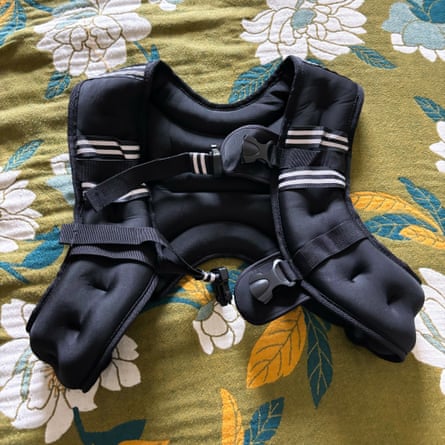A few months ago, something changed. One minute, people were trudging along as usual; the next it seemed like every third person I passed on the street was wearing a weird, heavy little backpack. Initially, I mistook several of these bulky, menacing items for bulletproof vests. (Scary.) Eventually, I realized they were simply the latest fitness trend: weighted vests.
Celebrities have been sporting them on walks, Peloton instructors are making videos explaining how to use them, and influencers are peddling them on TikTok. Publications have written about their growing popularity among “the menopause set”, as Allure put it, because of their supposed ability to help with muscle strength and bone density as one ages.
“It really has gotten so much attention lately,” says Dr Elaina Manolis, a physical therapist and clinical professor at Northeastern University. The practice used to be called “rucking”, she notes, because people would walk with heavy rucksacks.
One reason for this spike is that the vests don’t look so much like bulky backpacks anymore, Manolis suspects: “They’re sleek and cute,” she says. She also believes it’s part of a bigger societal trend. “Culture has shifted so much for the positive in women’s health, and in understanding the importance of strength training and bone density,” she says.
So are weighted vests the miracle workout upgrade some claim? I tried one for two weeks, and asked experts for advice.
What is a weighted vest?
They are vests that are weighed down with iron sand or small weights. “They can be thought of as ‘hyper-gravity’,” says Dr Abbi Lane, assistant professor of applied exercise science at the University of Michigan. “They add a little bit more weight and resistance.”
Typically, they weigh anywhere from five to 30lbs (2.26 to 13.6kg), and are worn across the shoulders and upper torso. Some are small, with straps across the chest. Others are bigger, cover most of the torso and look disconcertingly like bulletproof vests.
“Start with a vest that’s no more than five to 10% of your body weight, and build from there,” says Dr Mary Claire Haver, obstetrician-gynecologist and medical advisory board member of Let’s Talk Menopause.
I ordered a 16lb (7.25 kg) vest by a brand called Prodigen that seemed relatively comfortable and wouldn’t make me look like I was on my way to a gun range.
How do you use a weighted vest?
Weighted vests are different to other equipment in that they can be worn pretty much anywhere and at any time.
“Whereas you might do resistance training in a gym for 30 minutes twice a week, you could put on the weighted vest during other activities,” says Lane.
It’s still best to limit one’s use though, especially in the beginning.
“I don’t recommend it for everyday use,” says Manolis. Most daily tasks involve a lot of bending and stretching, and adding weight raises the risk of injury.
Manolis recommends wearing a vest when walking – which she calls “a very underrated exercise as it is” – because you are in an upright posture and the potential for injury is much lower.
If you are confident in the vest, you can also use it for “light aerobics, strength training and even short bouts of running”, says Haver. Make sure your joints can tolerate the load though. Start by wearing the vest for a short period of time, then build up. “Aim for 20-30 minutes a day, and listen to your body,” says Haver.
What does a weighted vest feel like?
Twice a week, for two weeks, I wore my vest for my current favorite physical activity: walking on the treadmill in the air conditioned gym while watching Vera on my iPad. When I first strapped it on, the vest felt heavy but oddly comforting – like a thunder shirt for dogs.
As I started walking, I was surprised by how off-balance I felt. It took me a few minutes to find my stride, and holding myself upright and centered required more core strength than I had expected. By the time my 30 minutes was up, DCI Vera Stanhope had realized that all was not as it seemed in her murder case, and I was breathing noticeably harder than usual.
Why did it feel more challenging? I have previously weighed 16lbs more than I do now, and I don’t recall feeling more tired when I walked.
When you wear a vest, “the weight is not distributed throughout the body,” explains Lane. “When I was 16lbs heavier, my legs and arms were bigger too. When you have the vest, it’s all in one place and you have to adjust your center of mass,” she says.
after newsletter promotion
This challenges your balance, but it’s important that the vest not be so heavy that it requires you to significantly change your gait. “That’s how injuries can happen,” she says.
Over time, I felt less off-kilter when I wore the vest. My walks felt more intense than usual, but not unpleasant.
What are the benefits of wearing a weighted vest?
Weighing down your body with a weighted vest has a number of benefits, says Manolis. When your body is heavier, moving requires more muscle, she explains. And over time, as more muscle develops, strength improves. The greater weight will also require more energy to move, and thus your body will burn more calories.
Some research shows that long-term use of weighted vests can prevent bone loss in postmenopausal women, a population particularly at risk for low bone density and resulting conditions like osteopenia and osteoporosis. Manolis suggests that this may be because the added top-down pressure that a vest places on one’s skeletal system can improve how quickly bones repair themselves.
Most studies on weighted vests and bone density have been small though, warns Lane – fewer than 20 people. The biggest study on the topic had 150 participants. The one-year, randomized control trial explored whether exercising with a weighted vest could offset bone loss in older adults who were trying to lose weight. It did not.
“The research here is not super fleshed out yet,” Lane says.
The flexibility and affordability of weighted vests mean they can still be a useful piece of equipment. “We’re finally talking about muscle and bone loss in midlife women,” says Haver. “And weighted vests are a simple, affordable way to help combat that.”
Ideally though, they would be used in conjunction with other forms of cardio and strength training. “I think of things like weighted vests as the cherry on top,” says Lane. “Potentially beneficial, but nothing replaces aerobic and resistance exercise.”
What are the risks of wearing a weighted vest?
The greatest risks come from wearing a vest that is too heavy, or wearing one for too long.
“It can cause joint strain, poor posture, or even back or knee pain,” says Haver. Proper fit and gradual progression are key, she says. And if you ever feel discomfort, stop. “Don’t push through pain,” she warns.
Verdict
I’ve worn my weighted vest a few more times since my two-week trial. I don’t love how sweaty it makes me. I’m also not sure about the best way to clean it as the manufacturer didn’t provide any instructions. (I’ve been using cleaning wipes – please don’t tell me if this is wrong.) But it is a nice way to add some difficulty and novelty to my Vera walks.
Still, I don’t think it’s going to become a staple in my routine. I strength train several times a week, and a set of heavy squats feels like a more effective, challenging and satisfying way of strengthening my legs and bones than walking with 16lbs of extra weight.
I did enjoy that it made me look like an action movie hero though. When I asked my partner how I looked in it, he responded: “Tactical.” That’s way cooler than my usual gym look: sweaty 30-something woman in a Rainforest Cafe T-shirt.









